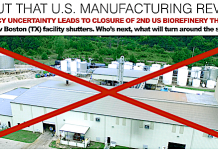by Debra Fiakas CFA
The last post “From Fuel to Fudge” discussed how the old Solazyme developer of algal-based renewable fuel has been transformed into a new company called TerraVia, (TVIA) which is pursing algal-based food and personal care products. Solazyme is not the only renewable fuel company to make an about face. Granted FutureFuel Corporation (FF: NYSE) has not changed its name or stock symbol like Solazyme. However, its ability to produce specialty chemicals has given FutureFuel an alternative to biofuels and its early plans to build a plant that could eventually produce 160 million gallons of biodiesel each year.
It took very little time from the company’s inception for FutureFuel strategists to pull back the biodiesel plant to a 40 million gallon name plate capacity. Even as the company was getting started in the 2006 and 2007 time frame, margins on biodiesel began to shrink. Management was worried. The plant finally ended up with a capacity to produce 58 million gallons of biofuels per year.
FutureFuel was already keeping the lights on by selling performance chemicals. As much as two-thirds of revenue in the early years was generated by the sale of specialty chemicals, including a bleach activator that was sold to a detergent manufacturer and a proprietary herbicide for a life sciences company. Biofuels accounted for only about a quarter of revenue. Fast forward to the year 2015, biofuels are providing the majority of sales and specialty chemicals have taken a back seat.
Fact of the matter is sales of BOTH specialty chemicals and biofuels have declined. Biofuel sales peaked in the year 2013, but have since declined on lower selling prices and volumes. Specialty chemicals sales peaked that year as well. The herbicide producer has stopped buying the herbicide additive and FutureFuel has had to accept a lower selling price for its bleach activator in order to keep its detergent manufacturer customer through the year 2018.
Rebuilding the specialty chemicals segment is a largely a matter of finding new customers. It is a situation over which the company has some control. It is a matter of marketing, branding and messaging. Then again it could be just a matter of salesmanship and good old fashion shoe leather.
Unfortunately, in its biofuel segment FutureFuel is experiencing plenty of difficulties – none of which are so easily resolved. Protecting profit margins from costly feedstock is just one of them. FutureFuel appears to have little latitude on feedstock even as other biodiesel and renewable diesel products have found success.
There are numerous biodiesel producers, some also using the transesterification process that FutureFuel uses. An increasing number are using less expensive feedstock, such as waste oils. For example, Diamond Green Diesel, the joint venture of Darling Ingredients (DAR: NYSE) and Valero Energy (VLO: NYSE) uses the waste oils that Darling collects from meat processing plants and restaurants around the country. Diamond Green just announced plans to expand production capacity. Another 125 million gallon capacity will be added by the end of 2017, bringing to total capacity to 275 million gallons per year.
Renewable Energy Group (REGI: Nasdaq) is also expanding storage capacity for both its waste oil feedstocks as well as finished biodiesel at its Danville, Illinois facility. The storage capacity is pivotal in allowing REG the flexibility of timing its sales at peak or at least better pricing. The ability to delay sales to wait for better prices is one of the keys to building profits in the fuel production industry. REG now has 45 million in annual biodiesel production and 12 million gallons in biodiesel storage capacity in Danville. This facility is only one of a dozen active biorefineries REG has in operation around the country.
In the most recently reported twelve months FutureFuel delivered $48.6 million in net income or $1.11 in earnings per share on $292.2 million in total sales. The company remains profitable, but comparisons to the previous twelve months are not favorable. Even in the most recently reported quarter ending March 2016, the company reported sales 10% lower than the previous year period. Earnings we well above expectations, but only because the company benefited from reinstatement of the blenders tax credit.
FutureFuel has tried to break free from its biofuel origins, finding new products and new customers. It seems investors might be doing the same. After a brief recovery, the stock has sold off, leaving FF priced at ten times expected earnings for the year 2016. We note that the stock was nearly at the same value about two years ago.
Debra Fiakas is the Managing Director of Crystal Equity Research, an alternative research resource on small capitalization companies in selected industries.
Neither the author of the Small Cap Strategist web log, Crystal Equity Research nor its affiliates have a beneficial interest in the companies mentioned herein. Crystal Equity Research has a buy rating on Darling Ingredients and a Hold rating on FutureFuel.







